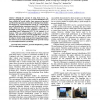1404 search results - page 18 / 281 » On optimal input design in system identification for control |
CDC
2010
IEEE
13 years 2 months ago
2010
IEEE
Abstract-- Recent results in networked control systems indicate substantial benefits of event-based control compared to conventional designs. This paper identifies structural prope...
TCAD
2008
13 years 7 months ago
2008
Latency-insensitive protocols allow system-on-chip (SoC) engineers to decouple the design of the computing cores from the design of the intercore communication channels while follo...
ICARCV
2008
IEEE
14 years 2 months ago
2008
IEEE
—In this paper, we study the problem of stabilizing a linear time-invariant discrete-time system with information constraints in the input channels. The information constraint in...
CDC
2009
IEEE
14 years 13 days ago
2009
IEEE
— We consider the problem of attitude stabilization using exclusively visual sensory input, and we look for a solution which can satisfy the constraints of a “bio-plausible” ...
ICPR
2010
IEEE
13 years 5 months ago
2010
IEEE
Although the concept of using brain waves, e.g. Electroencephalogram (EEG), for personal identification has been validated in several studies, some unanswered practical and theoret...

